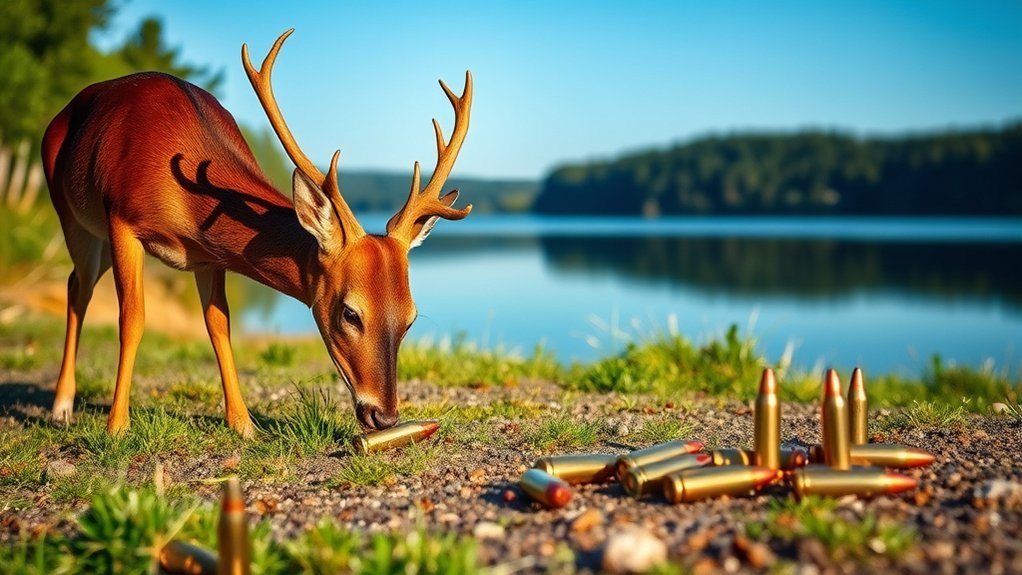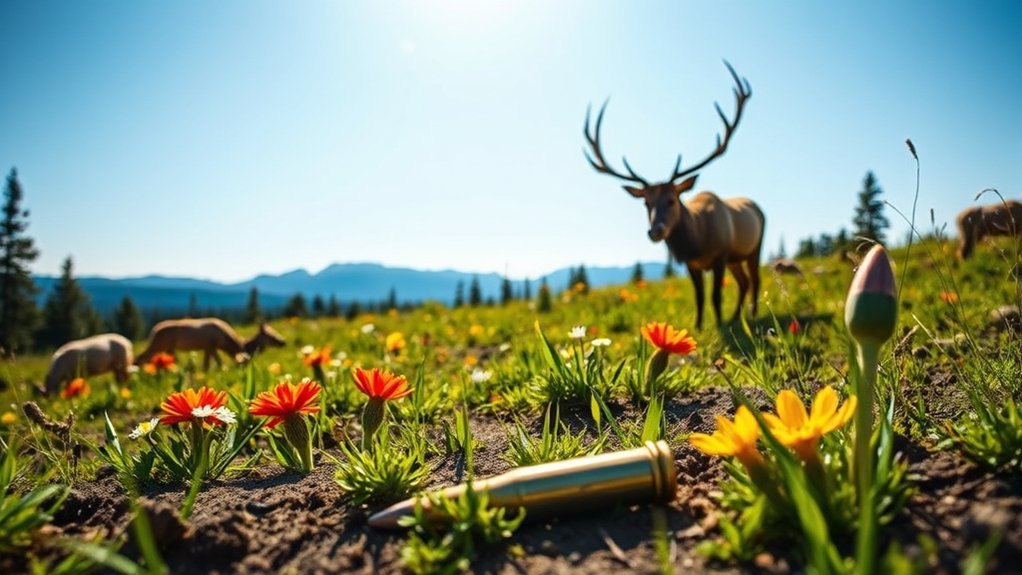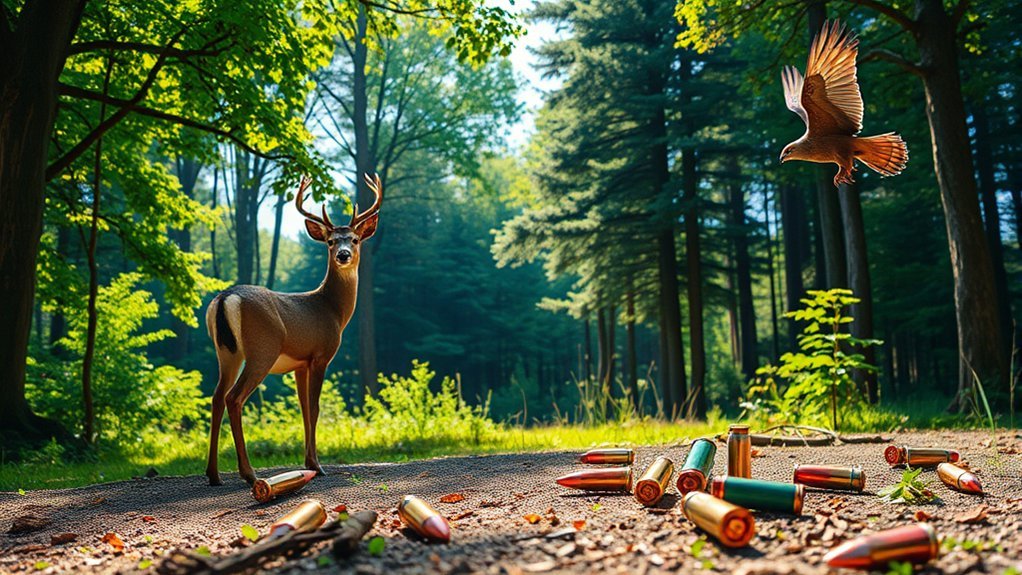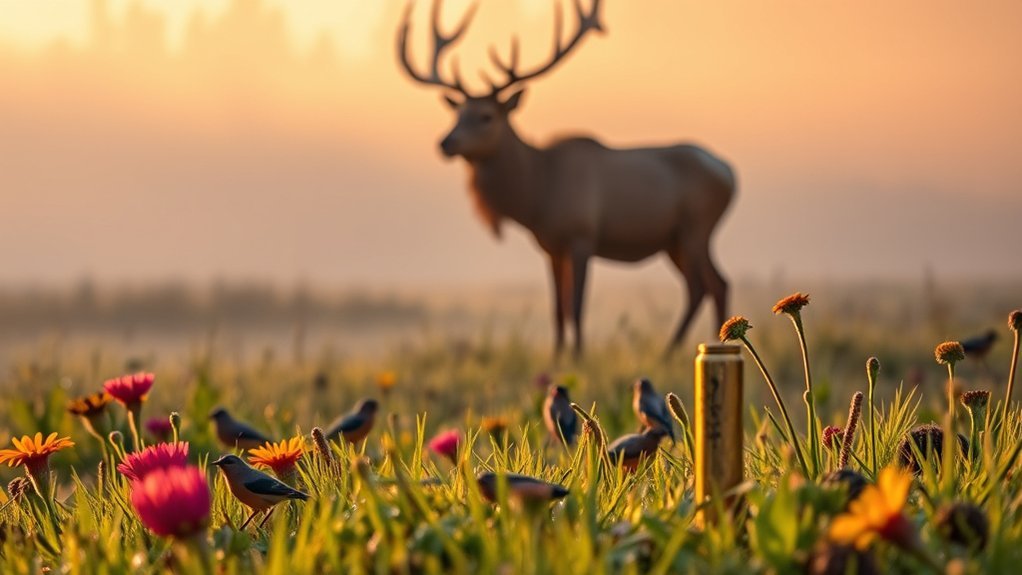Imagine a majestic eagle soaring through the sky, its keen eyesight scanning the ground below for food. Unfortunately, this scene is marred by the hidden dangers of lead ammunition, which poses a significant threat to wildlife. As you consider the implications of your hunting choices, it’s essential to understand how non-lead bullets can not only enhance your performance but also safeguard the ecosystems we cherish. What does this mean for the future of wildlife conservation?
The Dangers of Lead Ammunition

While you may not think about it, using lead ammunition poses significant risks to wildlife and ecosystems. When you fire lead bullets, tiny particles can scatter into the environment, contaminating soil and water. Birds and other wildlife often ingest these lead fragments, leading to poisoning that can be fatal. Even if you’re careful, scavengers like eagles and vultures are particularly vulnerable, as they consume carcasses shot with lead. This contamination doesn’t just harm individual animals; it disrupts entire food chains and ecosystems. Additionally, lead exposure can have long-term effects on wildlife populations, hindering their reproductive success. By reconsidering your ammunition choice, you can play an essential role in protecting wildlife and preserving the delicate balance of our ecosystems.
Benefits of Non-Lead Alternatives

Choosing non-lead alternatives for ammunition can considerably benefit wildlife and ecosystems. By reducing lead exposure, you help protect various species from poisoning. Non-lead bullets often have superior performance, delivering better accuracy and terminal ballistics, which can enhance your hunting experience. In addition, many non-lead options are designed to fragment on impact, minimizing the risk of leaving behind harmful debris. This means that not only are you safeguarding wildlife, but you’re also contributing to healthier ecosystems. Using these alternatives can foster a more sustainable hunting culture, promoting responsible practices among fellow hunters. Ultimately, by opting for non-lead ammunition, you’re taking an important step toward preserving biodiversity and ensuring a safer environment for all living creatures.
Impact on Wildlife Populations

When hunters opt for non-lead ammunition, they markedly reduce the negative effects of lead exposure on wildlife populations. Lead poisoning remains a significant threat to various species, and by choosing non-lead options, you can actively contribute to healthier ecosystems. Consider these impacts:
- Reduced Mortality Rates: Non-lead bullets help lower the number of animals suffering from lead poisoning, allowing populations to thrive.
- Improved Biodiversity: Healthier wildlife supports balanced ecosystems, promoting species diversity essential for resilience.
- Sustainable Hunting Practices: By embracing non-lead ammunition, you set a responsible example for future generations, ensuring that hunting remains a viable activity.
Health Risks to Humans
The choice of non-lead ammunition not only benefits wildlife but also significantly reduces health risks to humans. Lead exposure can occur through hunting, as lead fragments in game meat can enter your body when consumed. This can lead to serious health issues, including neurological damage, elevated blood pressure, and reproductive problems. By opting for non-lead options, you’re not just making a responsible choice for the environment—you’re also protecting your health. Non-lead ammunition, often made from copper or other materials, eliminates the risk of lead poisoning. As a hunter or outdoor enthusiast, prioritizing your well-being while ensuring a sustainable future for wildlife is essential. Switching to non-lead ammunition is a proactive step toward safeguarding both your health and the ecosystem.
Transitioning to Non-Lead Solutions
As you consider alternatives to traditional lead ammunition, it’s critical to understand the benefits and practicality of shifting to non-lead solutions. Embracing these alternatives not only enhances wildlife conservation but also promotes a healthier environment for everyone. Here are a few key advantages:
- Reduced Toxicity: Non-lead bullets minimize the risk of lead poisoning in wildlife, preserving ecosystems.
- Improved Performance: Many non-lead options offer comparable or superior accuracy and terminal ballistics to lead ammunition.
- Regulatory Compliance: As laws evolve, using non-lead ammunition guarantees you stay compliant and avoid potential penalties.
Transitioning to non-lead solutions isn’t just a trend; it’s a responsible choice that can greatly impact wildlife conservation efforts. Make the switch and contribute to a sustainable future.
Success Stories in Wildlife Conservation
You’ll find that innovative conservation strategies and strong community engagement have led to remarkable success stories in wildlife conservation. These approaches not only protect endangered species but also foster a sense of ownership among local populations. By examining these successes, you can see the powerful impact of collaboration and creativity in preserving our natural heritage.
Innovative Conservation Strategies
While traditional conservation efforts have made significant strides, innovative strategies are now reshaping the landscape of wildlife protection, showcasing success stories that inspire action. You might wonder how these fresh approaches are making a difference. Here are three standout examples:
- Technology Integration: Drones and camera traps track wildlife, providing real-time data for better decision-making.
- Community-Led Initiatives: Empowering local communities fosters stewardship, allowing residents to play an essential role in protecting their natural resources.
- Adaptive Management: Flexibility in conservation plans enables quick responses to environmental changes, ensuring wildlife populations thrive.
These strategies not only boost conservation outcomes but also engage diverse stakeholders, proving that innovation is key to sustainable wildlife protection. Embracing these methods can lead to a brighter future for our planet’s biodiversity.
Community Engagement Success
Innovative conservation strategies have illuminated the path toward effective community engagement in wildlife protection. You’ve likely seen how local initiatives empower communities to take ownership of their natural resources. For instance, programs that promote non-lead bullets not only reduce wildlife poisoning but also foster collaboration between hunters and conservationists. Involving local stakeholders in decision-making has proven essential; when people feel invested, they’re more likely to protect their environment. Success stories from various regions showcase how educational workshops and hands-on activities create a sense of stewardship. By embracing these strategies, you can inspire your community to actively participate in wildlife conservation efforts, ensuring healthier ecosystems and sustainable practices for future generations. Engaging communities leads to lasting change.
Future of Hunting and Environmental Stewardship
As hunters increasingly embrace non-lead ammunition, the future of hunting intertwines with environmental stewardship in unprecedented ways. This shift not only protects wildlife but also enhances the hunting community’s role in conservation. By adopting non-lead options, you’re actively participating in a sustainable future, fostering a positive relationship with nature.
Consider these benefits:
- Wildlife Health: Reducing lead exposure safeguards birds and other wildlife, promoting biodiversity.
- Public Perception: Demonstrating commitment to eco-friendly practices can improve hunting’s public image, attracting new supporters.
- Regulatory Support: Engaging in sustainable practices can lead to more favorable regulations and funding for conservation efforts.
Your choices today can shape a more responsible hunting culture, ensuring wildlife thrives for generations to come.
Conclusion
By choosing non-lead bullets, you’re not just improving your accuracy; you’re also safeguarding wildlife, supporting healthier ecosystems, and ensuring a sustainable future for hunting. Each shot fired with non-lead ammunition helps protect scavengers from lead poisoning, promotes biodiversity, and enhances environmental stewardship. Together, we can make a tangible difference in wildlife conservation. Embrace this change, advocate for non-lead solutions, and join the movement towards a healthier planet for all living beings.

